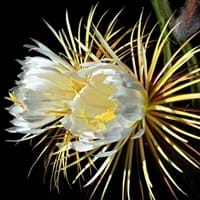Life Span
Perennial
Perennial
Type
Cactus or Succulent, Perennial
Fruit
Origin
North America, Central America, South America
Southeastern Asia
Types
princess of the night, Honolulu queen
Not Available
Habitat
Desert, Semi desert
Subtropical climates, Tropical regions
USDA Hardiness Zone
9-14
10-14
AHS Heat Zone
12 - 10
11-5
Sunset Zone
H1, H2, 12, 13, 15, 16, 17, 20, 21, 22, 23, 24
H1, H2, 22, 23, 24
Habit
Narrow Upright/Fastigiate
Arching/Fountain-shaped
Flower Color
Light Pink, White
Pink, Rose, Violet
Flower Color Modifier
Bicolor
Bicolor
Fruit Color
Pink, Purple, Salmon, Violet
Yellow, Orange, Light Yellow, Lemon yellow, Yellow green, Gold
Leaf Color in Spring
Light Green
Green
Leaf Color in Summer
Green, Dark Green
Green
Leaf Color in Fall
Green
Green
Leaf Color in Winter
Green
Light Green
Leaf Shape
Succulent
Oblovate
Plant Season
Fall, Spring, Summer, Winter
Spring, Summer, Fall
Sunlight
Full Sun, Partial Sun
Full Sun, Partial Sun
Type of Soil
Loam, Sand
Loam, Sand
The pH of Soil
Acidic, Alkaline, Neutral
Acidic, Neutral
Soil Drainage
Well drained
Average
Bloom Time
Late Spring, Spring
Early Spring, Spring, Late Spring, Early Summer, Summer, Late Summer
Where to Plant?
Container, Ground, Pot
Ground
How to Plant?
Grafting, Seedlings, Stem Planting
Seedlings, Stem Planting
Plant Maintenance
Medium
Low
Watering Requirements
Average Water Needs, Do not let dry out between waterings, Do Not over Water, Never Over-water, Requires consistently moist soil, Requires regular watering
Average Water Needs, Requires watering in the growing season
In Summer
Lots of watering
Lots of watering
In Spring
Average Water
Moderate
In Winter
Less Watering
Average Water
Soil pH
Acidic, Alkaline, Neutral
Acidic, Neutral
Soil Type
Loam, Sand
Loam, Sand
Soil Drainage Capacity
Well drained
Average
Sun Exposure
Full Sun, Partial Sun
Full Sun, Partial Sun
Pruning
Prune to stimulate growth, Remove damaged leaves, Remove dead branches, Remove dead leaves
Prune in winter, Remove damaged leaves, Remove dead leaves
Fertilizers
fertilize every 2-3 weeks while growing
Fertilize every year
Pests and Diseases
Scale
Red blotch
Plant Tolerance
Drought
Drought
Flower Petal Number
Semi-Double
Single
Foliage Texture
Bold
Medium
Foliage Sheen
Matte
Glossy
Attracts
Birds
Birds, Butterflies
Allergy
Diarrhea, Nausea, Vomiting
Kidney Stone
Aesthetic Uses
Beautification, Landscape Designing, Showy Purposes
Not Used For Aesthetic Purpose
Beauty Benefits
Improve hair condition, Improve skin condition
Not Available
Environmental Uses
Air purification
Air purification, Food for birds, Food for insects, Nesting sites for birds, Prevent Soil Erosion
Medicinal Uses
Antioxidants, cholesterol-lowering, Fever, Heart problems, Itching, Menstrual Disorders, Rheumatism, Treat Parasitic Intestinal Worms
Anti-oxidant, Antioxidants, High blood pressure, Nutrients
Part of Plant Used
Flowers, Stem
Fruits, Seeds
Other Uses
Decoration Purposes, Economic Purpose, Employed in herbal medicine, Medicinal oil, Showy Purposes, Used as Ornamental plant, Used for its medicinal properties
Oil is used in perfume, soaps, creams, etc., Used As Food, Used for its medicinal properties
Used As Indoor Plant
Yes
No
Used As Outdoor Plant
Yes
Yes
Garden Design
Container
Edible, Fruit / Fruit Tree, Tropical
Botanical Name
CEREUS
AVERRHOA carambola
Common Name
Night blooming cereus
Carambola, Starfruit
In Hindi
cereus
carambola पेड़
In German
cereus
Sternfrucht Baum
In French
cereus
arbre carambole
In Spanish
cereus
árbol de carambola
In Greek
cereus
carambola δέντρο
In Portuguese
cereus
árvore de carambola
In Polish
cereus
karambola drzewo
In Latin
cereus
carambola ligno
Phylum
Tracheophyta
Tracheophyta
Class
Magnoliopsida
Magnoliopsida
Order
Caryophyllales
Oxalidales
Family
Cactaceae
Oxalidaceae
Genus
Selenicereus
Averrhoa
Clade
Angiosperms, Core eudicots, Eudicots
Angiosperms, Eudicots, Rosids
Tribe
Hylocereeae
Not Available
Subfamily
Cactoideae
Not Available
Number of Species
Not Available
Season and Care of Cereus and Carambola
Season and care of Cereus and Carambola is important to know. While considering everything about Cereus and Carambola Care, growing season is an essential factor. Cereus season is Fall, Spring, Summer and Winter and Carambola season is Fall, Spring, Summer and Winter. The type of soil for Cereus is Loam, Sand and for Carambola is Loam, Sand while the PH of soil for Cereus is Acidic, Alkaline, Neutral and for Carambola is Acidic, Neutral.
Cereus and Carambola Physical Information
Cereus and Carambola physical information is very important for comparison. Cereus height is 250.00 cm and width 40.00 cm whereas Carambola height is 610.00 cm and width 610.00 cm. The color specification of Cereus and Carambola are as follows:
Cereus flower color: Light Pink and White
Cereus leaf color: Light Green
Carambola flower color: Pink, Rose and Violet
- Carambola leaf color: Green
Care of Cereus and Carambola
Care of Cereus and Carambola include pruning, fertilizers, watering etc. Cereus pruning is done Prune to stimulate growth, Remove damaged leaves, Remove dead branches and Remove dead leaves and Carambola pruning is done Prune in winter, Remove damaged leaves and Remove dead leaves. In summer Cereus needs Lots of watering and in winter, it needs Less Watering. Whereas, in summer Carambola needs Lots of watering and in winter, it needs Average Water.





